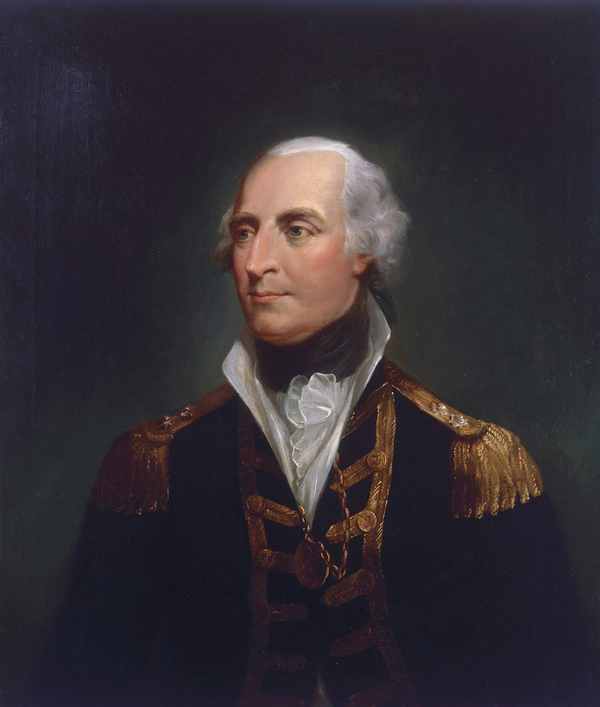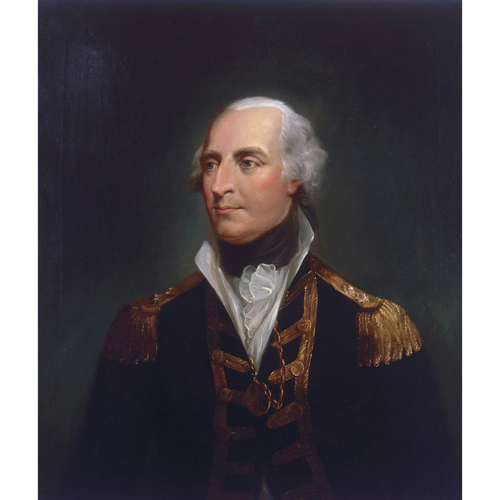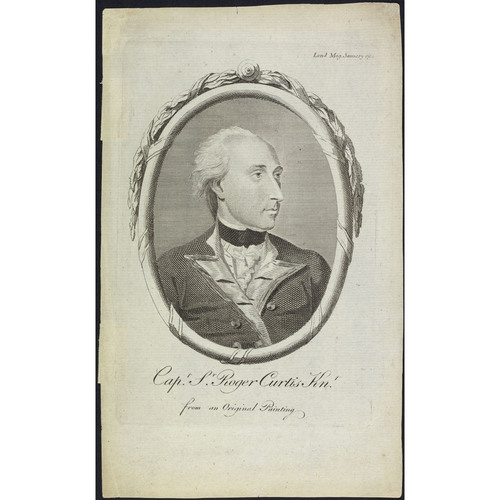
Source: Courtesy of Wikimedia Commons
CURTIS, Sir ROGER, naval officer; b. 4 June 1746 in Downton, Wiltshire, England, only son of Roger Curtis, a prominent farmer, and Christabella Blachford; m. December 1778 Jane Sarah Brady, daughter and heiress of Matthew Brady of Gatcombe House (Gatcombe), England, and they had two sons and one daughter; d. 14 Nov. 1816 at Gatcombe House.
At the age of 16, Roger Curtis travelled to Portsmouth to join his first ship, the Royal Sovereign, on 22 June 1762. After voyages in this and other vessels, he spent three years on the Newfoundland station during the governorship of Hugh Palliser* as a midshipman in the frigate Gibraltar. He then served briefly in the Venus and the Albion under Captain Samuel Barrington, who became a lifelong friend.
On 28 Jan. 1771 Curtis was promoted lieutenant and posted to the sloop Otter. In her he spent the next three summers on the coast of Labrador and rapidly became familiar with the geography, fisheries, and peoples of this remote region. At the end of his second summer he compiled a lengthy account of the coast, dedicating it to the secretary of state for the American Colonies, Lord Dartmouth, who was especially interested in the welfare of the natives. He sweepingly dismissed the land of Labrador itself as “nothing more than a prodigious heap of barren rocks,” but was enthusiastic about the prospects for a valuable cod fishery. He strongly believed that it should be carried on by annual ship fishers from Great Britain rather than by Canadians from fixed posts on the coast. As far as he could see, the Inuit lacked any kind of religion, laws, or government, but he noted that they did not drink, seldom quarrelled with each other, and as yet had few diseases, not even smallpox, and “consequently have the happiness to be without Physicians.”
In 1773 the British government took a renewed interest in the Labrador coast and its fisheries. One result was that Curtis was directed both to visit the Moravian missionaries at their post at Nain and to see whether there were resources “capable of being rendered national advantages” on the northern coasts. On 14 July he left Chateau Bay in the armed shallop Sandwich, with an Inuit pilot. After travelling along the coast almost to Hudson Strait and visiting Nain, the Sandwich returned to Chateau Bay on 26 August. Governor Molyneux Shuldham* had by then arrived and Curtis was able to report to him directly. Shuldham described Curtis favourably as a “very sensible Officer” and forwarded home accounts the lieutenant had drawn up on the northern coast of Labrador and the Moravian mission there.
Curtis accompanied his report on northern Labrador with a chart of the coast which he considered superior to any yet produced. It outlined the sea coast fairly accurately, but he obviously had not had the time to explore the many intricate bays and inlets, although he was able to quash the notion that Davis Inlet might be a passage to Hudson Bay and beyond. He felt that valuable seal and walrus fisheries could be carried on in northern Labrador: Inuit were at a loss to describe the vast numbers of seals which came to certain places in the spring and fall, and walruses flocked ashore on islands north of Nain. He identified the chief tribes or settlements of Inuit and estimated their total population from observation and information at about 1,625, which was probably reasonably accurate.
Curtis was full of praise for the Moravian Brethren and wonder at the work already accomplished [see Christian Larsen Drachart*; Jens Haven*]. Speaking through a missionary interpreter, he had warned the assembled Inuit at Nain against killing or robbing Europeans or other Inuit, and the natives had pledged fidelity to the king of Great Britain and obedience to his representatives. The mission settlement, concluded Curtis, was “of infinite use to the Fishery upon this Coast, as by softning the manners of the Savages, the Adventurers will run but little risk of future annoyances, and I think [they are] extremely deserving of the Protection and the Encouragement of Government.” Curtis’s favourable report on the mission undoubtedly helped the Moravians to secure in 1774 land grants for further posts. His offer to continue his explorations in 1774 was not taken up, but he did succeed in having his impressions of Labrador presented to the Royal Society that year by Daines Barrington, a brother of Captain Barrington.
Authorities on the Labrador coast have had mixed opinions of Curtis’s work. Thomas Pennant in his Arctic zoology (2v., London, 1784–85) stated that the Labrador coast “so admirably described by that honored name, Sir Roger Curtis, is barren past the efforts of cultivation,” although since his work was based on the information of others he would have had no grounds to be critical of Curtis’s statements. Captain George Cartwright, who lived on the coast in the 1770s and 1780s and who had no doubt met Curtis there, noted rather sourly in his copy of Pennant that Curtis had pirated his chart and invented most of his account of the country, since he was ignorant of the good soil and large trees to be found in many parts. William Gilbert Gosling*, the historian of Labrador, condemned Curtis’s chart as “very crude and incorrect,” and a modern scholar, Averil M. Lysaght, has argued that some of the Moravian charts were better. Since Curtis’s explorations were largely confined to the sea coast, his impressions of the barrenness of the country are understandable.
Curtis never returned to Labrador after 1773. He was now high in the favour of Shuldham, and when the latter was appointed commander-in-chief on the North American station in 1775, he took Curtis with him to New York. Admiral Lord Howe, who succeeded Shuldham, quickly came to regard Curtis with equal esteem. In April 1777 he was promoted captain and given command of the Eagle, Howe’s flagship. Curtis was sent to the Mediterranean in 1780 as captain of the frigate Brilliant. In April 1781 he brought a relief convoy into besieged Gibraltar and organized a naval brigade which was active in the defence of the fortress against the Spaniards. After Lord Howe raised the siege in 1782, Curtis was promoted commodore and knighted. At the same time he had to defend himself against a sharp personal attack launched by a disgruntled naval officer, Lieutenant Coll Campbell, who had served in the Brilliant. Campbell wrote a pamphlet charging him with errors of judgment and, in some cases, downright dishonourable behaviour under stress. Although some of the accusations had substance, the naval establishment remained solidly on the side of the hero of Gibraltar and nothing came of the charges.
According to a contemporary biographer, Sir Roger possessed elegant and engaging manners, a highly developed understanding, and a warm and friendly heart. He was certainly articulate and well spoken, with a talent for getting along well with people whose friendship he wished to cultivate. In 1783 he was appointed ambassador to the emperor of Morocco and the Barbary States, and was successful in restoring good trading and diplomatic relations. Another diplomatic mission, secret in nature, took him to Sweden, Denmark, and Russia in 1789. On the outbreak of war with France in 1793, Curtis took command of the Queen Charlotte, the flagship of his old patron Lord Howe. The famous victory of the “Glorious First of June,” 1794, brought him promotion to rear-admiral and a baronetcy. In 1799 he was advanced to vice-admiral and appointed commander in-chief at the Cape of Good Hope. There he established the beginnings of the famous naval base at Simonstown. Sir Roger retired from active sea service at the Treaty of Amiens (1802) but became a full admiral in 1804 and in January 1809 was appointed commander-in-chief at Portsmouth naval base, where he had joined his first ship almost 50 years before. Through his wife, Curtis had come into possession of Gatcombe House, and he lived there until his death in 1816. His eldest son, Roger, a captain in the navy, predeceased him, and the bulk of the estate thus descended to his second son, Lucius, also a navy captain.
Curtis’s connection with Canada came at the beginning of an illustrious career when he was a young and ambitious officer anxious to make his mark. He was the first British naval officer to survey the northern coast of Labrador and no other followed him for almost 50 years. That his reports were in some respects superficial and naïve is not surprising, given his youth, his lack of training, and the limited time at his disposal. If they reflected the biases natural to an 18th-century naval officer, they also contained a humanity and sense of fairness which such officers often displayed. In spite of their imperfections, they advanced knowledge of a difficult and remote region.
The following reports by Sir Roger Curtis on Labrador are located in the PRO: “A short account of the territory of Labradore” (CO 194/30: ff.156–91), dated 1772; “An account of the Moravian mission upon the coast of Labrador” (CO 194/31: ff.58–65), dated 1773; and “Remarks upon the northern parts of the coast of Labrador” (CO 194/31: ff.38–53), dated 1773. All are available on microfilm at the PAC, which also possesses the original of Curtis’s “Proposal for a further exploration of the northern coast of Labrador” (MG 23, A1, 2: 2417–29), dated 1773. His observations on the region were published in “Particulars of the country of Labradore, extracted from the papers of Lieutenant Roger Curtis, of his majesty’s sloop the ‘Otter,’ with a plane-chart of the coast,” Royal Soc. of London, Philosophical Trans., 64 (1774): 372–88. His 1784 “Memorandum relative to my embassy to the emperor of Morocco” is preserved in the National Maritime Museum, JOD/157/1–2.
PRO, ADM 1/470, 1/2118; ADM 36/6801, 36/7456, 36/7530; ADM 51/663; ADM 52/1387; PROB 11/1586/610. Annual biog. and obituary (London), 1 (1817): 380–91. “Biographical memoir of Sir Roger Curtis, Bart . . .. Naval Chronicle, 6 (July–December 1801): 261–76. [Coll Campbell], A new edition of the appeal of a neglected naval officer: to which are now added, the reply of Sir Roger Curtis, intersected with remarks of Lieut. Campbell . . . (London, [1785]). Naval Chronicle, 36 (July–December 1816): 440. James Ralfe, The naval biography of Great Britain . . . (4v., London, 1828), 2: 32–44. DNB. W. G. Gosling, Labrador: its discovery, exploration, and development (London, 1910). A. M. Lysaght, Joseph Banks in Newfoundland and Labrador, 1766: his diary, manuscripts and collections (London and Berkeley, Calif., 1971).
Cite This Article
William H. Whiteley, “CURTIS, Sir ROGER,” in Dictionary of Canadian Biography, vol. 5, University of Toronto/Université Laval, 2003–, accessed December 14, 2025, https://www.biographi.ca/en/bio/curtis_roger_5E.html.
The citation above shows the format for footnotes and endnotes according to the Chicago manual of style (16th edition). Information to be used in other citation formats:
| Permalink: | https://www.biographi.ca/en/bio/curtis_roger_5E.html |
| Author of Article: | William H. Whiteley |
| Title of Article: | CURTIS, Sir ROGER |
| Publication Name: | Dictionary of Canadian Biography, vol. 5 |
| Publisher: | University of Toronto/Université Laval |
| Year of publication: | 1983 |
| Year of revision: | 1983 |
| Access Date: | December 14, 2025 |




